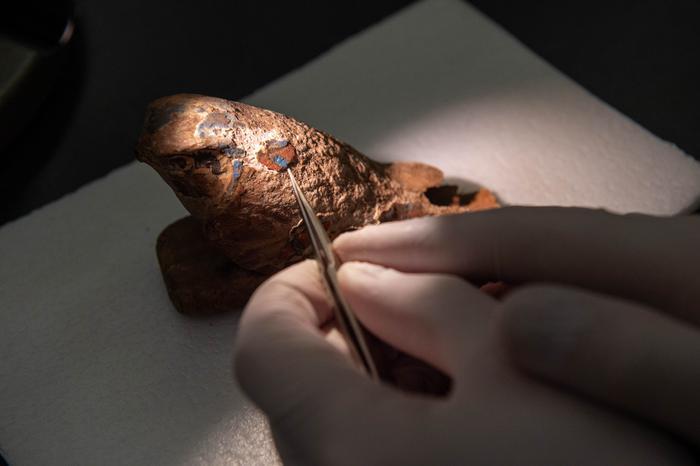PULLMAN, Washington – Egyptian blue is the world’s oldest known synthetic pigment, created by ancient Egyptian artisans around 2600 BCE. More than just a striking color, this vivid blue held powerful religious and symbolic meaning.
Egyptian blue represented divinity, the heavens, water, and protection, and was used to decorate tombs, statues, and temple walls—especially in scenes of gods, the afterlife, and the celestial sky. In ancient Egypt, color was never just decoration; it was a way to communicate with the divine. Egyptian blue served not only as an artistic material but as a sacred pigment believed to connect the earthly and spiritual realms. Its use in funerary art and sacred spaces shows how deeply color and spirituality were intertwined.
But Egyptian blue is more than just a relic of ancient belief—it’s also a marvel of early chemistry. The pigment is incredibly durable, maintaining its brilliant color for thousands of years. It even possesses a surprising modern property: it glows under near-infrared light, a trait known as near-infrared luminescence. Today, this characteristic has promising applications in fields like art conservation, forensics, biomedical imaging, and even anti-counterfeiting technology. Once lost to time, the process for making Egyptian blue is now being rediscovered and appreciated anew, not just as a glimpse into the past, but as a key to future innovation.

An ancient wooden Egyptian falcon with Egyptian blue. Photo Credit: Matt Unger, Carnegie Museum of Natural History [Courtesy
Last month, scientists from Washington State University (WSU) successfully recreated Egyptian blue using ancient-style techniques and modern tools. The project, published in the journal NPJ Heritage Science, was a collaboration with the Carnegie Museum of Natural History and the Smithsonian’s Museum Conservation Institute. The researchers developed 12 different versions of the pigment, experimenting with various ingredients and heating times. These new insights are helping archaeologists and conservationists better understand how the pigment was originally made and used.
“We hope this will be a good case study in what science can bring to the study of our human past,” said John McCloy, the study’s lead author and director of WSU’s School of Mechanical and Materials Engineering. “The work is meant to highlight how modern science reveals hidden stories in ancient Egyptian objects.”
Despite Egyptian blue’s widespread use in ancient times, very little physical evidence remains to show how it was actually produced. It was often used as a substitute for rare and costly minerals like lapis lazuli or turquoise and applied to wood, stone, and even a papier-mâché-like material known as cartonnage. The exact shade could vary, ranging from deep blue to dull gray or even green, depending on the recipe and heating process used.

Composiition of the Egyptian blue pigemt and its location on a sarcophagus [via NPJ Heritage Science – Courtesy
Over time, especially after the Roman period, the knowledge of how to make Egyptian blue faded. By the Renaissance, it had been completely forgotten. But recent scientific interest has revived attention to this ancient pigment, not just for its beauty, but for its high-tech potential. “It started out just as something that was fun to do because they asked us to produce some materials to put on display at the museum,” McCloy said. “But there’s a lot of interest in the material.”
The team included a diverse group of experts, such as a mineralogist and an Egyptologist. They created their pigment mixtures using silicon dioxide (basically sand), copper, calcium, and sodium carbonate. These mixtures were heated to about 1,000 degrees Celsius (similar to what ancient Egyptian kilns could reach) for one to 11 hours, and then cooled in different ways. The scientists analyzed the results using high-tech microscopes and methods never before applied to Egyptian blue, comparing the samples to two real ancient artifacts.
What they discovered was that the pigment is surprisingly variable. Slight differences in ingredients or heating time could change the color dramatically. “You had some people who were making the pigment and then transporting it, and then the final use was somewhere else,” McCloy explained. “One of the things that we saw was that with just small differences in the process, you got very different results.”
What seemed even more surprising is that the team found that only about half of the pigment mixture needs to be made up of blue-producing materials to create the desired color. “It doesn’t matter what the rest of it is, which was really quite surprising to us,” said McCloy. “You can see that every single pigment particle has a bunch of stuff in it — it’s not uniform by any means.”
Today, the pigment samples created by the WSU-led team are on display at the Carnegie Museum of Natural History in Pittsburgh, Pennsylvania. They are part of a new long-term exhibit dedicated to ancient Egypt.
The Wild Hunt is not responsible for links to external content.
To join a conversation on this post:
Visit our The Wild Hunt subreddit! Point your favorite browser to https://www.reddit.com/r/The_Wild_Hunt_News/, then click “JOIN”. Make sure to click the bell, too, to be notified of new articles posted to our subreddit.